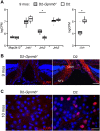Jnk2 deficiency increases the rate of glaucomatous neurodegeneration in ocular hypertensive DBA/2J mice
- PMID: 29899326
- PMCID: PMC6000001
- DOI: 10.1038/s41419-018-0705-8
Jnk2 deficiency increases the rate of glaucomatous neurodegeneration in ocular hypertensive DBA/2J mice
Abstract
The cJun N-terminal kinases (JNKs; JNK1, JNK2, and JNK3) promote degenerative processes after neuronal injury and in disease. JNK2 and JNK3 have been shown to promote retinal ganglion cell (RGC) death after optic nerve injury. In their absence, long-term survival of RGC somas is significantly increased after mechanical optic nerve injury. In glaucoma, because optic nerve damage is thought to be a major cause of RGC death, JNKs are an important potential target for therapeutic intervention. To assess the role of JNK2 and JNK3 in an ocular hypertensive model of glaucoma, null alleles of Jnk2 and Jnk3 were backcrossed into the DBA/2J (D2) mouse. JNK activation occurred in RGCs following increased intraocular pressure in D2 mice. However, deficiency of both Jnk2 and Jnk3 together did not lessen optic nerve damage or RGC death. These results differentiate the molecular pathways controlling cell death in ocular hypertensive glaucoma compared with mechanical optic nerve injury. It is further shown that JUN, a pro-death component of the JNK pathway in RGCs, can be activated in glaucoma in the absence of JNK2 and JNK3. This implicates JNK1 in glaucomatous RGC death. Unexpectedly, at younger ages, Jnk2-deficient mice were more likely to develop features of glaucomatous neurodegeneration than D2 mice expressing Jnk2. This appears to be due to a neuroprotective effect of JNK2 and not due to a change in intraocular pressure. The Jnk2-deficient context also unmasked a lesser role for Jnk3 in glaucoma. Jnk2 and Jnk3 double knockout mice had a modestly increased risk of neurodegeneration compared with mice only deficient in Jnk2. Overall, these findings are consistent with pleiotropic effects of JNK isoforms in glaucoma and suggest caution is warranted when using JNK inhibitors to treat chronic neurodegenerative conditions.
Conflict of interest statement
The authors declare that they have no conflict of interest.
Figures







References
-
- Anderson DR, Hendrickson A. Effect of intraocular pressure on rapid axoplasmic transport in monkey optic nerve. Invest. Ophthalmol. 1974;13:771–783. - PubMed
-
- Burgoyne CF, Downs JC, Bellezza AJ, Suh JK, Hart RT. The optic nerve head as a biomechanical structure: a new paradigm for understanding the role of IOP-related stress and strain in the pathophysiology of glaucomatous optic nerve head damage. Prog. Retin. Eye. Res. 2005;24:39–73. doi: 10.1016/j.preteyeres.2004.06.001. - DOI - PubMed
-
- Quigley HA, Anderson DR. Distribution of axonal transport blockade by acute intraocular pressure elevation in the primate optic nerve head. Invest. Ophthalmol. Vis. Sci. 1977;16:640–644. - PubMed
Publication types
MeSH terms
Substances
Grants and funding
LinkOut - more resources
Full Text Sources
Other Literature Sources
Medical
Molecular Biology Databases
Research Materials
Miscellaneous

